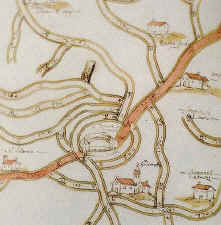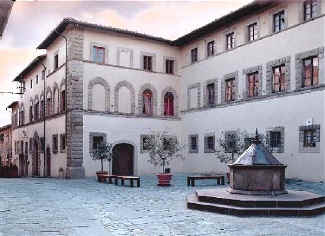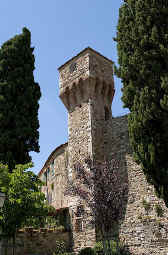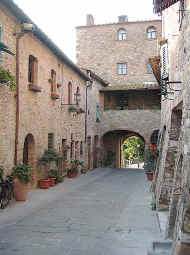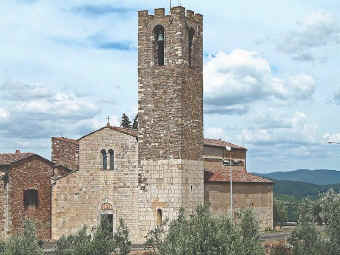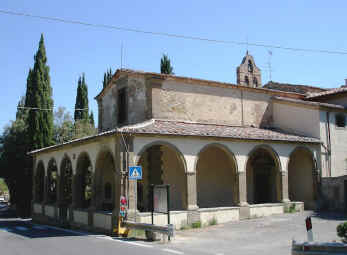|
San Donato in Poggio (italiano) This charming destination is a mediaeval walled village located, like so many Tuscan towns, on a hill ("Poggio"), from which it takes part of its name, and that separates the Val di Pesa from the Val d'Elsa. San Donato was a 4 C bishop of Arezzo, martyred and later a popular saint. The earliest written records that refer to San Donato in Poggio are three parchments dated 985, 986, 988 held in the provincial archives and another dated 989 from the Abbey of Passignano. In mediaeval times, the castle was named San Donato in "Loco Pocie", "Poce", or in "Podio" and subsequently San Donato in Poggio. In 1033 it became a fortified castle, a "Castrum". In 1091 Henry VI granted half of San Donato in Poggio, in feif, to the Counts of Guidi. It gained a strategic importance, in the mid-13 C, as it was on the Roman road that connected Florence to Sienna. Click here for vacation accommodation in and near San Donato. Early map showing San Donato on the old Roman road In late mediaeval times, following the conflicts between Guelphs and Ghibellines, San Donato was twice the place chosen for the signing of peace treaties between Florence and Sienna. In 1260 the Florentine army assembled in the castle before the battle of Montaperti against the Republic of Sienna. In 1289 it was partially destroyed by the Ghibelline Aretini during the war with Florence, but after the raid, the Florentine Republic and the parish priest of San Donato, Bernardo Gherardini (descendent of a family that possessed many properties, villas and castles in Val di Pesa), financed the immediate reconstruction and the expansion of the town walls. In 1313, the town, now a fortress, was seized by the forces of Arrigo VII. As a result of administrative rearrangements of the city of Florence and its surroundings, San Donato in Poggio became the headquarters of the Val di Pesa League, ruled by a PodestÓ sent by the Florentine Republic.
Today, only part of the fortified walls remain, including the two main gates (Porta Fiorentina and Porta Senese), the bell tower (the Campanone), the watchtower overlooking the valley (the Torrino) and a number of buildings that have preserved the original mediaeval structure of their towers, portals and arches, all constructed mostly of alberese stone. The mediaeval layout of the streets and the main piazza are also preserved. Piazza Malaspina is very atmospheric, with an octagonal well and surrounded by the Palazzo Ticci, now known as the Palazzo Malaspina, the church of Santa Maria della Neve (14 C) and the Palazzo Pretorio. The latter was destroyed during WW II, as were numerous other buildings such as the Porta Senese, but has been reconstructed. Piazza and Palazzo Malaspina, San Donato in Poggio Inside the Palazzo Pretorio, there is still a fresco dating from the second half of the 14 C, representing the Madonna and Child among the Saints. Outside the fortified walls there was a hospice for the poor managed by the Augustan monks that later on was passed to the confraternity of Santa Maria delle Neve.
Around the year 1000, the Pieve di San Donato was constructed outside the walls of the castle. This church is one of the most typical examples of the Florentine Romanesque architecture. It has three aisles terminating in three semi-circular apses, that envelop the pre-existing bell tower. The fašade is constructed of squared albarese filaretto, and inside there is a baptismal font in glazed terracotta by Giovanni Della Robbia (1513), a crucifix attributed to Taddeo Gaddi (1300 - 1366, a disciple of Giotto for 24 years). Other works that used to be displayed on the walls of the baptistery are now preserved in the Museum of the Church of San Stefano on the Ponte Vecchio in Florence. The Sanctuary of Santa Maria delle Grazie is located in Pietracupa and houses important works by Domenico Cresti, known as "Il Passignano", and by Gamberucci. The beautiful image of Virgin Mary with the Child is a fresco of the 15 C, attributed for a long time to Masaccio, but recently re-attributed to Paolo Schiavo. |

